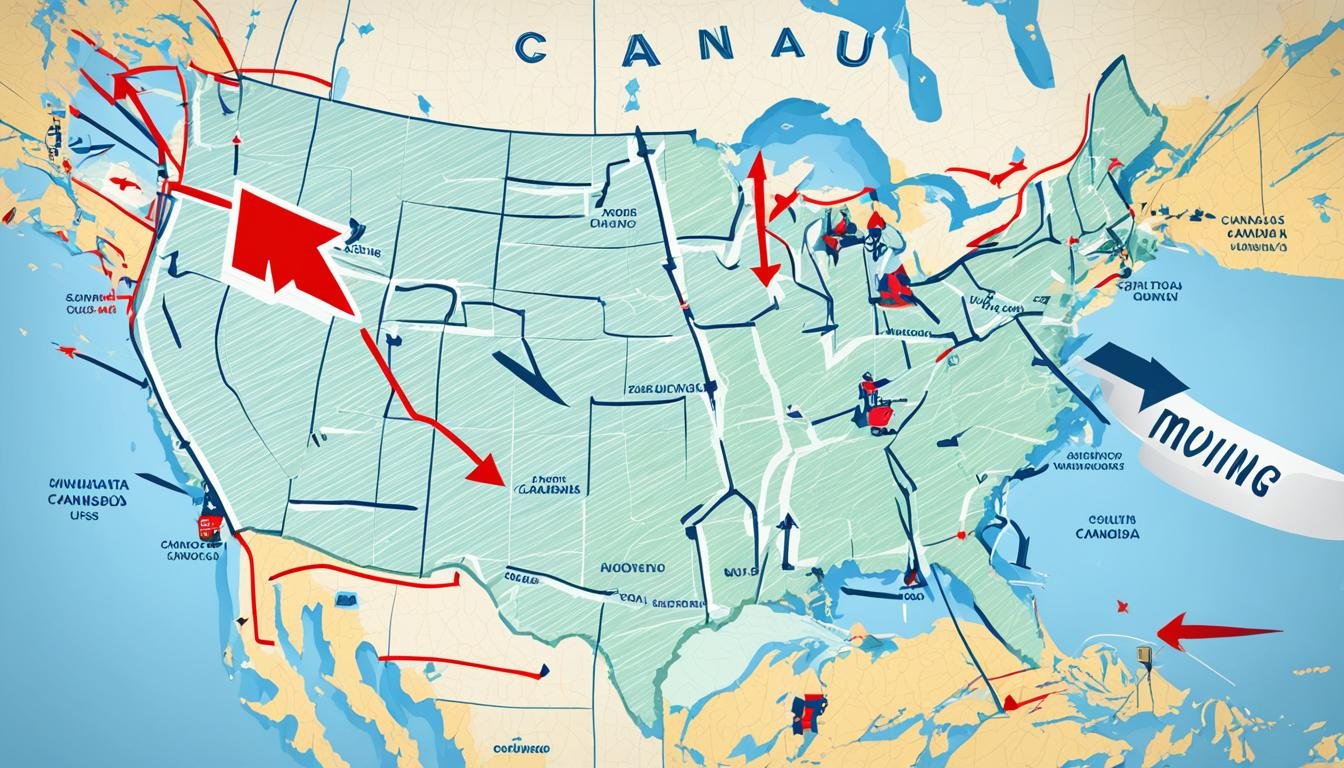Are you considering moving from Canada to the United States? Whether it’s for work, education, or a change of scenery, relocating to a new country can be an exciting but daunting prospect. From navigating legal requirements to finding the right moving services, there are several factors to consider for a successful transition. But what are the key steps and essential tips you need to know before making the move?
In this comprehensive guide, we will walk you through the necessary steps and provide valuable insights to ensure a smooth and hassle-free move from Canada to the US. From obtaining the right documentation to adapting to a new culture, we’ve got you covered.
So, if you’re ready to embark on this cross-border adventure, let’s dive into the essential information you need to know to make your relocation from Canada to the United States a success.
Key Takeaways:
- Planning and preparation are key for a successful move from Canada to the US.
- Ensure you have a valid Canadian passport before starting the immigration process.
- Determine the type of US visa you need based on your purpose of relocation.
- Choose between hiring a cross-border moving service or handling the move yourself.
- Understand the customs requirements and complete the necessary paperwork for a smooth transition.
Step 1: Valid Canadian Passport
Before embarking on your move from Canada to the US, it’s crucial to ensure that you have a valid Canadian passport. A passport is a travel document that serves as proof of your identity and nationality. Without a valid passport, Canadian citizens won’t be able to enter the US.
Passports have an expiration date, so it’s essential to check the validity of your passport well in advance of your planned move. If your passport is nearing expiration, it’s highly recommended to request a new one to avoid any delays or complications.
The processing times for passport applications can vary, so it’s crucial to factor in sufficient time for the application process. You can visit the official website of the Canadian government or contact the local passport office to find out the current processing times. Submitting your application early will give you peace of mind and ensure that you have a valid passport before your move.
Having a valid Canadian passport is the first step towards a smooth transition when moving from Canada to the US.
Step 2: Applying for a US Visa
Once you have a valid Canadian passport, the next step in your move from Canada to the US is to apply for a US visa. The type of visa you need will depend on the purpose and duration of your stay in the US.
Immigrant Visa
If you plan to move permanently to the US, you will need to apply for an immigrant visa. This type of visa is typically sponsored by a family member or an employer in the US. To begin the process, your sponsor will need to file a petition on your behalf with the US Citizenship and Immigration Services (USCIS). Once the petition is approved, you can proceed with your immigrant visa application.
Nonimmigrant Visa
If your stay in the US is temporary, such as for work, school, or tourism, you will need to apply for a nonimmigrant visa. There are different categories of nonimmigrant visas, each with specific requirements and limitations. Some common nonimmigrant visa categories include the B1/B2 visa for business or pleasure, the F visa for students, and the H-1B visa for temporary skilled workers.
The visa application process involves filling out specific forms, providing supporting documents, and paying the application fee. It is important to carefully review the requirements for your specific visa category and ensure that you provide accurate and complete information when submitting your application.
Note that some visa categories may require a US sponsor or a job offer from a US employer, while others may require proof of financial means to support yourself during your stay. Additionally, certain visas may also require you to obtain a US Social Security Number (SSN) once you arrive in the US.
Tip: It is recommended to consult with an immigration lawyer or seek guidance from the US embassy or consulate in Canada to ensure a smooth visa application process.
Visa Sponsorship
For immigrant visas, the sponsoring individual or organization will be responsible for initiating and supporting your visa application. They will need to demonstrate their ability to financially support you and comply with the necessary sponsorship requirements. For nonimmigrant visas, your employer, educational institution, or the purpose of your visit (such as tourism) may serve as your sponsor.
Keep in mind that the visa sponsorship process can vary depending on the visa category and your individual circumstances. It is essential to gather all required documents and meet the specific criteria for your visa application to increase your chances of approval.
US Social Security Number (SSN)
Upon arrival in the US, you may need to obtain a US Social Security Number (SSN), depending on the type of visa you hold and your intended activities in the country. An SSN is a unique nine-digit number issued by the Social Security Administration (SSA) for tax and identification purposes.
The process for obtaining an SSN will be explained to you by the US immigration authorities or the SSA. Generally, you will need to complete an application form, provide the necessary documents, and visit a local Social Security office to finalize the process.
Image:https://www.youtube.com/embed/1S-TniatuYw
Types of US Visas
| Visa Category | Purpose | Duration |
|---|---|---|
| Immigrant Visa | Permanent residence | Indefinite |
| Nonimmigrant Visa | Temporary stays | Varies by category |
Step 3: Choosing a Cross-Border Moving Service
When it comes to moving from Canada to the US, you have several options for transporting your belongings. One popular choice is to hire a cross-border moving service, which specializes in handling international moves seamlessly. These services provide the expertise and resources needed to navigate the complexities of customs clearance and transportation.
One option is to hire full-service movers who will take care of every aspect of your move from start to finish. They will handle packing, loading, transportation, and unloading, allowing you to focus on other aspects of your relocation. Full-service movers are a convenient choice for those who prefer a hands-off approach and want to ensure that their belongings are handled with care.
For those looking for a more budget-friendly option, DIY moves are an alternative worth considering. With a DIY move, you take on the responsibility of packing and loading your belongings, while the moving service handles the transportation and customs clearance. This option allows for more flexibility and control over your move, as you can decide how to pack and organize your items.
One well-known and affordable DIY moving service is U-Pack. With U-Pack, you can pack your belongings at your own pace and load them into a portable storage container. U-Pack will then transport the container across the border and handle the customs clearance process. This option provides a cost-effective solution for those on a tight budget, without sacrificing the convenience of using a moving service.
When choosing a cross-border moving service, it’s important to consider your specific needs and budget. Take time to research different options, read reviews from other customers, and compare prices. Remember that each service may offer different levels of service and coverage, so make sure to clarify the details before making your decision.
The Benefits of Choosing a Cross-Border Moving Service:
- Expertise in handling international moves
- Convenience of full-service movers
- Flexibility and control with DIY moves
- Affordable options like U-Pack
| Cross-Border Moving Service | Full-Service Movers | DIY Moves (U-Pack) |
|---|---|---|
| Handles customs clearance | ✓ | ✓ |
| Provides packing and loading | ✓ | ✗ |
| Handles transportation | ✓ | ✓ |
| Offers flexibility and control | ✗ | ✓ |
| Cost | Higher | Affordable |
Step 4: Completing US Customs Paperwork
Moving to the US requires completing customs paperwork to clear your belongings through US Customs. This crucial step ensures that your items are properly documented and cleared for entry into the country.
When completing the US customs paperwork, it is important to have all the required documents for moving to the US. These documents may include:
- A copy of your passport and visa
- The completed US Customs Form 3299
- An itemized list of your belongings
The US Customs Form 3299 is a document that declares your personal effects and household goods that you are bringing with you to the US. This form requires detailed information about the items, including their estimated values.
Additionally, you may be required to provide additional documentation based on your citizenship and the type of visa you have. It is important to check with the US Customs and Border Protection (CBP) for any specific requirements.
Completing the customs paperwork accurately and thoroughly is essential for a smooth customs clearance process. It helps ensure that your belongings are properly accounted for and that you comply with the US customs regulations.
Note: It is advisable to keep a copy of all the customs paperwork and supporting documents with you during your move and have an additional set easily accessible in case of any inquiries or inspections from the CBP.
Once you have completed the customs paperwork, it is important to keep it readily available for inspection by CBP officials when you arrive in the US. Having all the necessary paperwork in order will help expedite the customs clearance process and allow you to proceed with your move smoothly.
Now that you understand the importance of completing US customs paperwork, let’s move on to the next step: Tips for Managing Costs and Finances.
Tips for Managing Costs and Finances
Before and after your move to the US, it is essential to consider and plan for various financial aspects. Here are some tips to help you manage your costs and finances effectively.
- Research the Cost of Living in the US: The cost of living can vary significantly between cities and states. Take the time to research and understand the cost of housing, transportation, groceries, healthcare, and other essential expenses in your desired location. This knowledge will help you create a realistic budget.
- Create a Budget: Based on the cost of living information you gather, create a detailed budget to track your income and expenses. Consider factors such as rent or mortgage payments, utilities, transportation costs, food expenses, healthcare, and entertainment.
- Open a US Bank Account: Opening a US bank account is crucial for managing your finances effectively. It allows you to receive your salary, pay bills, and easily transfer money. Research different banks and choose one that offers convenient online banking options and suits your needs.
- Obtain a US-Based Credit Card: Having a US-based credit card will simplify your financial transactions and help you establish a credit history in the country. Look for credit card options that offer rewards, cashback, or low-interest rates, depending on your priorities.
- Be Aware of Tax Implications: Moving to the US may have tax implications for both your Canadian income and your new US income. Familiarize yourself with the tax regulations and consult with tax professionals to ensure compliance. Understanding your tax obligations will help you plan and avoid any unexpected financial burdens.
To ensure a smooth financial transition, it is advisable to seek financial advice from professionals who specialize in cross-border financial planning and taxation. They can guide you through the process and provide personalized recommendations based on your specific circumstances.
Cost of Living Comparison in Select US Cities
| City | Monthly Rent (1-Bedroom Apartment) | Groceries (Monthly) | Transportation (Monthly) | Utilities (Monthly) |
|---|---|---|---|---|
| New York City | $2,600 | $400 | $130 | $150 |
| San Francisco | $3,600 | $375 | $120 | $120 |
| Los Angeles | $2,300 | $350 | $100 | $140 |
| Chicago | $1,700 | $300 | $105 | $110 |
The table above provides a comparison of the cost of living in select US cities. Remember that these figures are approximate and can vary based on several factors such as location within the city and amenities included. Use this information as a starting point for your budgeting process and adjust according to your specific circumstances.
Finding Temporary and Permanent Housing
When you first arrive in the US, finding suitable housing is essential for a smooth transition. It is often beneficial to consider temporary housing options, such as extended hotel stays or short-term rentals, while you familiarize yourself with the area and explore your permanent housing options.
Researching local housing options is crucial to ensure you find a place that meets your needs and preferences. Consider factors such as location, amenities, and proximity to schools and healthcare facilities. By gathering information about the U.S. housing market, you can make informed decisions about your housing choices.
If you’re unfamiliar with the area or unsure about navigating the housing market, consider working with a real estate agent. Real estate agents have extensive knowledge of the local market and can guide you through the process of finding suitable permanent housing. They can help you narrow down your options, arrange viewings, and negotiate rental or purchase agreements.
One important consideration is whether you should rent or buy a home. Renting provides flexibility and allows you to get a feel for different neighborhoods before committing to a long-term investment. Buying a home, on the other hand, offers the stability of homeownership and the potential for building equity.
Temporary Housing Options
Temporary housing options offer the convenience and flexibility you need during your transition. Consider the following options:
- Extended hotel stays: Many hotels offer discounted rates for long-term stays. This option provides the convenience of amenities and services.
- Short-term rentals: Websites like Airbnb and VRBO offer a wide range of short-term rental options, from apartments to houses. These rentals often come fully furnished, providing a comfortable living space.
Permanent Housing Considerations
When searching for permanent housing, it’s important to consider the following factors:
- Location: Choose a neighborhood that aligns with your lifestyle and offers amenities and services that are important to you.
- Budget: Determine a budget that allows you to comfortably afford housing expenses, including rent or mortgage payments, utilities, and maintenance costs.
- Amenities: Identify the amenities that are essential to you and prioritize them in your search. This may include proximity to schools, parks, public transportation, or shopping centers.
By carefully considering your temporary and permanent housing options and working with professionals like real estate agents, you can find a place to call home in the US that suits your needs and preferences.
Navigating Healthcare and Education Systems
Moving to a new country involves navigating new healthcare and education systems. It’s important to familiarize yourself with the US healthcare system, find a healthcare provider, and transfer your medical records. Additionally, exploring health insurance options and understanding US school enrollment procedures is crucial, especially if you have school-age children.
US Healthcare System
The US healthcare system differs from the Canadian system, so it’s essential to understand how it works. Research local healthcare providers and services in your new location to find a suitable healthcare provider. Consider factors such as proximity, specialties, and insurance network participation. Additionally, transferring your medical records to your new healthcare provider will ensure seamless continuity of care.
“Navigating the US healthcare system can be complex, but with proper research and preparation, you can find quality healthcare tailored to your needs.”
Health Insurance Coverage
One of the most important aspects of healthcare in the US is health insurance coverage. Determine if your employer provides health insurance and understand the coverage details and requirements. If not, explore individual health insurance options available in your new location. Understanding the specifics of your health insurance coverage will help you access medical services and manage healthcare costs effectively.
Transferring Medical Records
Prior to your move, contact your Canadian healthcare providers to obtain copies of your medical records. These records are vital for your new healthcare provider to understand your medical history and provide appropriate care. Make sure to securely transfer these records to your new healthcare provider in the US. This will facilitate continuity of care and help your new provider make informed decisions about your healthcare needs.
US School Enrollment
If you have school-age children, researching the US school enrollment process is crucial. Start by identifying the schools in your desired location and familiarize yourself with their enrollment requirements and timelines. Contact the school district or individual schools to gather the necessary documentation and schedule any required interviews or assessments. Understanding the enrollment process will ensure a smooth transition for your children and help them settle into their new educational environment.
As you prepare for your move from Canada to the US, take the time to learn about the healthcare and education systems in your new country. By familiarizing yourself with the US healthcare system, finding a healthcare provider, transferring medical records, exploring health insurance options, and understanding the US school enrollment process, you’ll be well-equipped to navigate these important aspects of your new life in the US.
Adapting to US Culture and Building Relationships
Moving to the US means immersing yourself in a new cultural environment. To ease your transition and build meaningful connections, it’s important to embrace cultural adaptation, navigate social customs, understand language nuances, engage with expatriate communities, and prioritize building relationships.
Embrace Cultural Adaptation
Cultural adaptation plays a vital role in integrating into your new American life. Be open-minded and receptive to new experiences, customs, and traditions. Take the time to understand the values and beliefs that shape American society. By embracing cultural differences, you’ll foster a sense of understanding and acceptance, which will enhance your ability to adapt and thrive.
Navigate Social Customs
Every culture has its own set of social customs, and the United States is no exception. Observing and adhering to social etiquette is crucial for building positive relationships and avoiding misunderstandings. From greetings to table manners, familiarize yourself with American customs to navigate social situations with confidence and respect.
Understand Language Nuances
While English is the predominant language in the US, it’s important to be aware of the language nuances and regional dialects. Familiarize yourself with common American phrases, idioms, slang, and pronunciation variations. Engage in conversations, listen attentively, and ask questions when necessary. This will enable effective communication and help you connect with others on a deeper level.
Engage with Expatriate Communities
Expatriate communities provide a valuable network of support, enabling you to connect with fellow Canadians or individuals from your home country who are also living in the US. Join local expatriate groups, attend cultural events, and participate in community activities to meet like-minded individuals who understand the unique challenges and experiences of living abroad.
Prioritize Building Relationships
Building relationships is key to creating a sense of belonging and establishing a support system in your new home. Be proactive in reaching out to neighbors, colleagues, and other members of your community. Attend social gatherings, participate in community organizations, and explore shared interests. By investing time and effort into building relationships, you’ll foster lasting connections that will enrich your experience in the US.
Adapting to US culture and building relationships takes time and effort, but it’s a crucial part of successfully transitioning to your new life. Embrace the opportunities for personal and cultural growth, and remember that each interaction is a stepping stone towards creating a fulfilling and rewarding experience in the United States.
| Benefits of Cultural Adaptation and Building Relationships | Challenges of Cultural Adaptation and Building Relationships |
|---|---|
| 1. Enhanced understanding of American culture | 1. Language barriers |
| 2. Increased opportunities for personal and professional growth | 2. Feeling homesickness and nostalgia |
| 3. Development of a support system | 3. Adjusting to different social norms |
| 4. Exposure to diverse perspectives and experiences | 4. Overcoming cultural differences and stereotypes |
Conclusion
Moving from Canada to the US is an exciting adventure that requires careful planning and consideration. By following the steps outlined in this guide and taking into account the various factors involved, you can ensure a successful transition and a smooth start to your new life in the US. Remember to plan ahead, gather all the necessary documents, and seek professional advice when needed. Good luck with your move!
What is the first step when moving from Canada to the US?
The first step is to ensure you have a valid Canadian passport.
What type of visa do I need when moving to the US?
The type of visa you need will depend on the reason for your move. Immigrant visas are for permanent stays, while nonimmigrant visas are for temporary stays.
What documents are required to clear customs when moving to the US?
You will need to provide a copy of your passport and visa, complete US Customs Form 3299, and provide an itemized list of your belongings.
How should I manage my finances when moving to the US?
Research the cost of living, open a US bank account, obtain a US-based credit card, and consult with tax professionals to ensure compliance with tax requirements.
What should I do for temporary housing when I first arrive in the US?
Consider extended hotel stays or short-term rentals while you familiarize yourself with the area. Work with a real estate agent to find suitable permanent housing.
How do I navigate the US healthcare and education systems?
Familiarize yourself with the US healthcare system, find a healthcare provider, transfer your medical records, and research schools in your desired location.
Q: Is it hard for a Canadian to move to the US?
A: Moving to the US from Canada can be challenging, as it requires obtaining the appropriate visa or green card. The process can be complex and time-consuming, and the requirements vary depending on the individual’s circumstances, such as employment, family ties, or study plans.
Q: How do I permanently move from Canada to the USA?
A: To move permanently from Canada to the USA, you’ll need to obtain an immigrant visa or green card. Some common pathways include:Family sponsorship (if you have a close relative who is a US citizen or permanent resident)
Employment-based visas (if you have a job offer from a US employer)
Diversity Visa Program (a lottery-based system for countries with low immigration rates to the US)
Q: How much does it cost for a Canadian to move to the US?
A: The cost of moving from Canada to the US varies depending on factors such as the visa type, legal fees, moving expenses, and the cost of living in your destination city. Visa application fees can range from a few hundred to several thousand dollars, and you may need to show proof of financial support. Moving costs will depend on the volume of your belongings and the distance of your move.
Q: How can a Canadian move to the US to work?
A: To work in the US as a Canadian, you’ll need to obtain a work visa. Some common work visas include:H-1B visa (for specialty occupations)
L-1 visa (for intracompany transferees)
TN visa (for professionals under the USMCA agreement)
Each visa category has its own requirements and application process.
Q: Can I live in the USA as a Canadian citizen?
A: Canadian citizens can live in the USA if they obtain the appropriate visa or green card. As a Canadian, you may be eligible for certain visas that are not available to citizens of other countries, such as the TN visa under the USMCA agreement.
Q: What is the cheapest way to move from Canada to the US?
A: The cheapest way to move from Canada to the US will depend on your specific situation. Some cost-saving tips include:Decluttering and selling unwanted items before moving
Comparing prices from multiple moving companies
Considering a self-move using a rental truck
Choosing a less expensive destination city
Q: Is it cheaper to live in Canada or the USA?
A: The cost of living in Canada and the USA varies depending on the specific city and region. In general, the cost of living in the US is slightly lower than in Canada, particularly when it comes to consumer goods and housing. However, healthcare costs are typically higher in the US than in Canada.
Q: Which country is easiest to move to from Canada?
A: The ease of moving to another country from Canada depends on factors such as visa requirements, language barriers, and cultural differences. Some countries that may be relatively easy for Canadians to move to include:United States (due to geographic proximity and visa options like the TN visa)
United Kingdom (due to shared language and historical ties)
Australia and New Zealand (due to similar cultural backgrounds and visa options)
Q: How long can a Canadian stay in the US?
A: As a Canadian citizen, you can stay in the US for up to 6 months without a visa, provided you have a valid passport and meet other entry requirements. If you want to stay longer or plan to work or study in the US, you’ll need to obtain the appropriate visa.
Q: Does my Canadian health insurance cover me in the US?
A: Most Canadian health insurance plans do not provide coverage for medical expenses incurred in the US. It’s important to purchase travel health insurance when visiting the US, even for short trips. If you’re moving to the US, you’ll need to obtain health insurance coverage that is valid in the US.
Q: What happens if Canadians overstay in the USA?
A: If a Canadian overstays their authorized stay in the US, they may face consequences such as:Being barred from re-entering the US for a certain period
Difficulty obtaining visas in the future
Deportation
Fines and other penalties
Q: Can a Canadian retire in the US?
A: Yes, Canadians can retire in the US, but they must obtain the appropriate visa. Some options for retiring in the US as a Canadian include:Obtaining a green card through family sponsorship or other means
Applying for a non-immigrant visa, such as an E-2 investor visa or an EB-5 investor green card
Spending part of the year in the US as a visitor (up to 6 months at a time)
It’s important to note that Canadians retiring in the US will need to navigate healthcare, tax, and other financial considerations.















